The building of a Stone Rialto bridge was decided in 1525
After deliberations in the Senate, a decision was finally made to build a new stone Rialto Bridge.Three experts, three "Provveditori" noble members of the Senate, were appointed to study the question.
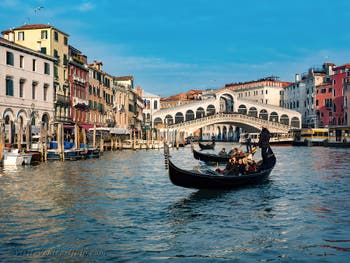
The Rialto Bridge Several models and projects were requested, and Michelangelo, passing through Venice in the autumn of 1529, proposed his project for a bridge for the Rialto.
But opinions about the shape and structure of the future Rialto Bridge were so divergent that the decision to restore the wooden bridge, which still threatens to collapse, is made instead of the decision to build a new stone bridge.
In January 1551, twenty-five years later, the Senate appointed a new group of three experts who asked architects to submit stone construction projects for the Rialto Bridge.
Among those who bid are the names of Giacomo Barozzi Vignola, Andrea Palladio, Vincenzo Scamozzi (who tendered in 1583) or Jacopo Sansovino.
And the project was still dragging on, slowed down by many external elements, including the resumption of the war against the Turks.
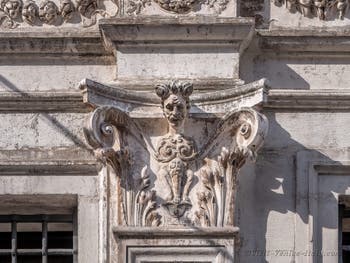
The Rialto Bridge Venetians no longer believed in getting a stone bridge because of a money shortage.
In 1575 and 1577, the epidemics of the Black Death slowed down the project.
In 1574 and 1577, the fires of the Doge’s Palace also focused on the finances of the Venetian Republic on the reconstruction of the Doge's residence rather than that of the Rialto Bridge.
In the meantime, imagine people’s reactions, using their easy and often mocking speech.
Mocking Couple Carved in Front of the Rialto Bridge
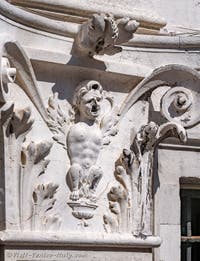
The Rialto Bridge A couple was said to bet with the Camerlenghi, the state’s financiers, who were with them in a trattoria in Rialto.
The main reason for the repeated postponement of the stone bridge was linked to the finances of the Serenissima.
Hence, the man told the Camerlenghi that the Rialto Bridge might be built of stone when the Treasury of Venice would grow like nails.
According to Giuseppe Tassini (Curiosità Veneziane), the words of the bet made by the couple are very different:
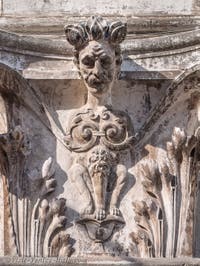
The Rialto Bridge The Man:
"Voglio che, se ciò si farà, mi nasca un' unghia fra le coscie!"
"If it’s done, a nail should grow between my thighs!"
His wife added:
"Voglio che le fiamme m'abbrucino la natura!"
"and a fire should burn my nature."
You will understand that "nature" alludes to a particular part of the woman’s body.
When the bridge got built, the sculptors carved the bettors on the facade of the Palazzo dei Camerlenghi, just to the right and at the bottom of the bridge.
That story explained the presence of two bas-reliefs, which are particularly intriguing.
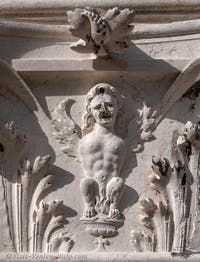
The Rialto Bridge We see a man sitting, legs apart, with a third leg that grew between his thighs; this third leg surmounted by a "fleece" is very suggestive.
As for the woman, with a grin on her lips, visibly suffering horribly while a fire devours her lower abdomen, just like in her bet.
For the Rialto Bridge, One Arch or Three Arches?
In 1587, the project of a stone bridge was finally admitted into people’s minds, and now the question arises of the number of arches that the future Rialto Bridge should have.Some architects favoured three arches for safety reasons, arguing that a single-arch bridge would only collapse because of its heavier-than-average weight and width since there would still be shops.
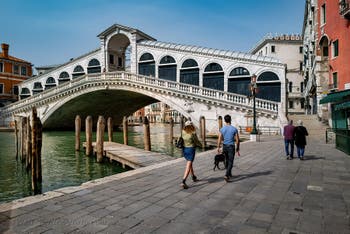
The Rialto Bridge The architectural problem posed by keeping the shops became inevitable because of the fear of paying excessive compensation to the merchants installed on the wooden bridge.
Functional considerations for the future bridge took precedence over aesthetics for experts who gave architects the respect of eight points concerning functionality compared to only one for beauty.
In addition, a bridge with a single large arch was best suited to the heavy traffic of boats on the Grand Canal.
On January 28 1588, the Senate voted on constructing the Rialto Bridge
Finally, eighty years after the idea of building a stone Rialto bridge, Antonio Da Ponte, the architect appointed to carry out this work, began the work on the same day as the vote!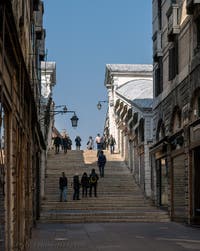
The Rialto Bridge The construction site supplied elm, larch wood, bricks, and stones.
Six thousand piles got sunk on each bank to support the new Rialto stone bridge, 12,000 stilts in total!
On August 9, 1588, a new and final coup.
A Provveditore (an expert) appointed by the Senate, Marcantonio Barbaro, whose motion for a three-arch bridge had been rejected by the same Senate, presented a motion.
Barbaro asked for a halt to work, arguing that the bridge was in danger of collapsing because of inappropriate techniques and the piers’ stability was questioned.
On August 26, Antonio Da Ponte responded to criticism with models to back up, and construction could resume.
Antonio Da Ponte was not only a good architect because his bridge stood there for more than four centuries, but he was also a pragmatic man who perfectly integrated into his project the three imperatives required of the Senate: solidity, functionality and beauty.
The Rialto Bridge's Beauty
Beauty was also crucial because Venice wanted its unique bridge at the time on the Grand Canal to be one of the most beautiful in Italy.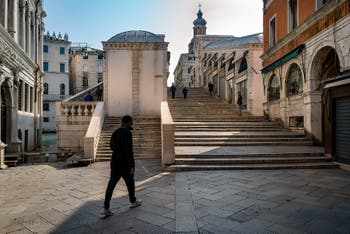
The Rialto Bridge The works lasted two years, and the famous bridge of Venice, so admired by its tourists, got completed at the beginning of 1591.
The Rialto Bridge in Venice, a technical feat of which Michelangelo would be the father
Some say that the plans of the future Rialto Bridge, drawn up by Michelangelo in 1529, would have served as the basis for those of Antonio Da Ponte.As these plans have disappeared, it is tough to confirm.
However, it should be noted that Da Ponte achieved a remarkable architectural and technical feat here by ingeniously designing its Rialto Bridge.
Imagine the weight constraints of this bridge, which has three pedestrian passageways, and two lines of shops (24 in all).
The Rialto Bridge: Built on 12,000 Stilts
A bridge built entirely of Istrian stone and marble with a unique arch of 28 metres span and located 7 metres 50 above the water, all built on 12,000 stilts!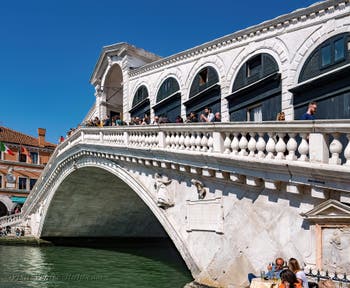
The Rialto Bridge The Rialto Bridge of Da Ponte also managed to reconcile all the requirements of the Senate by being both functional and relatively beautiful, as the Serenissima wanted.
It is a useful bridge with its three pedestrian lanes because, while shopkeepers’ customers crowd the central axis on which the shops open, the two lateral lanes make it possible to cross it more quickly.
It is also functional with its double upper entrance that allows you to pass easily from one side of the bridge to the other to admire the Grand Canal, an essential element when you know the importance of the bridge for the Venetians who gather there on festive days to admire the processions of boats including the famous Bucintoro.
Still functional with its curvature, allowing you to cross it without much fatigue despite the height of its arch at 7 metres 50.
The Rialto Bridge: an imposing and original look
Finally, this beautiful bridge shows an imposing and original look and joins the two banks harmoniously without hindering their architecture.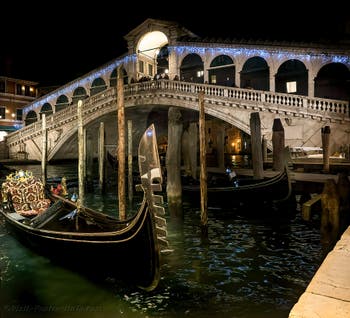
The Rialto Bridge The Rialto Bridge is perfectly integrated into the urban landscape of this part of the Grand Canal.
This last point, beauty, was also an essential element for the Republic of Venice.
It wanted its Rialto Bridge, a technical feat, to be admired by Venetians and foreign countries for its beauty.
The Rialto Bridge, therefore, also represented a political impact.
When it comes to the decoration of the bridge, many agree that the sculptures are not the most impressive element of the bridge.
However, the main symbols of Venice are on the sides of the Rialto Bridge.
On one side are Saint Mark and Saint Theodore, the two protectors of the Republic, and on the other, The Annunciation.
History of the Rialto Bridge
Back to Top of Page

